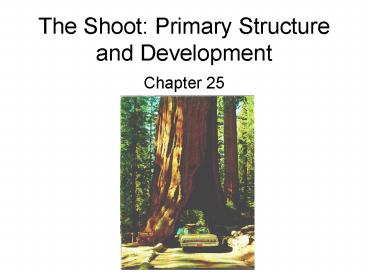The Shoot: Primary Structure and Development - PowerPoint PPT Presentation
1 / 26
Title:
The Shoot: Primary Structure and Development
Description:
... forms at the tip of a rhizome. i.e. Potato. Bulb- a shortened underground stem covered by enlarged fleshy storage leaves. i.e. Onion and garlic. – PowerPoint PPT presentation
Number of Views:225
Avg rating:3.0/5.0
Title: The Shoot: Primary Structure and Development
1
The Shoot Primary Structure and Development
- Chapter 25
2
- True or False
- Shoots contain stems and leaves.
- Shoots are the above ground portion of the plant
and are anatomically the same as roots.
3
The Shoot
- Shoot- the above ground portion of the plant,
consisting of stem and leaves. - Stem- the above ground axis of vascular
plants. - Leaf- the principle lateral appendage of the
stem. - Foliage leaf- photosynthetic organ.
- Node- the part of the stem where one or more
leaves are attached. - Internode- the region of the stem between two
successive nodes. - Bud- an embryonic shoot protected by young
leaves.
4
Primordium- a leaf or bud in its earliest stage
of differentiation.
5
Pith- the ground tissue occupying the center of a
root or shoot.
6
Pith- the ground tissue occupying the center of a
root or shoot.
Corn
Alfalfa
Basswood
7
Modified Stems
- Tendrils- modified leaves that spirally coil and
aid in stem support. - Stolons- runners stems that grow horizontally on
the soil surface, often giving rise to new plants
at the nodes. - Thorns- hard, woody, sharp-pointed modified
stems, arise from the axils of leaves. - Spines- hard, woody, sharp-pointed modified
leaves or leaf-parts. - Prickles- a small non-woody, sharp-pointed
outgrowth of bark or the epidermis.
8
True or False. This is a tendril.
9
True or False. This is also a tendril.
10
- Given the following is a hard, woody,
sharp-pointed modified stem that arises from the
axils of leaves. - True or False.
- This is a spine.
11
Spines
12
Prickles
13
Underground Stems
- Rhizome- a horizontal stem that grows at or below
the soil surface. - Tuber- an enlarged, short, fleshy underground
stem, forms at the tip of a rhizome. i.e. Potato. - Bulb- a shortened underground stem covered by
enlarged fleshy storage leaves. i.e. Onion and
garlic. - Corm- a thickened underground stem with small
papery leaves. i.e. Gladiolus and Crocus.
14
(No Transcript)
15
Leaf Arrangement
- Phyllotaxy- the arrangement of leaves on a stem.
- Basal- leaves are attached to an underground stem
or rhizome. - Opposite- 2 leaves attached at each node, borne
on opposite sides of the stem. - Alternate- 1 leaf attached at each node.
- Whorled- 3 or more leaves at each node.
Basal
16
Leaf Morphology
- Blade- lamina.
- Petiole- stalklike portion.
- Stipules- scalelike or leaflike appendages at the
base of leaves. - Simple vs. Compound Leaves
- Simple- blades undivided.
- Compound- blades divided into leaflets.
- Pinnately compound- leaflets arising from both
sides of the axis. - Palmately compound- leaflets diverge from the tip
of the petiole.
17
(No Transcript)
18
(No Transcript)
19
(No Transcript)
20
(No Transcript)
21
Leaf Histology
- Mesophyll- the ground tissue of the leaf,
specialized for photosynthesis. - Palisade parenchyma- upper cells.
- Spongy parenchyma- lower cells.
22
Hydrophyte- waterlily.
Xerophyte- oleander.
23
Eudicot- random stomata.
Monocot- parallel stomata.
24
(No Transcript)
25
(No Transcript)
26
Leaf Abscission
- Abscission- the normal separation of the leaf
from the stem. - Structural and chemical (ethylene) changes result
in the formation of an abscission zone - Separation layer
- Protective layer
- Magnesium ions, sugars, amino acids.































